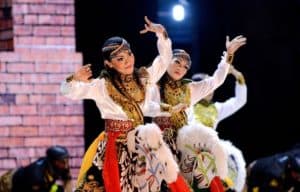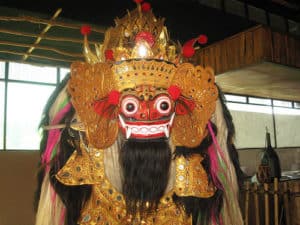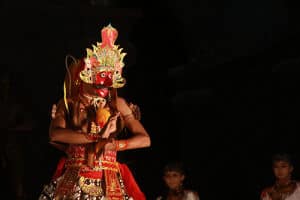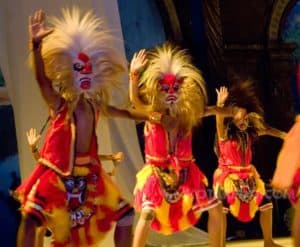Reog Ponorage dance is art culture tradition came from Ponorogo, East Java. Ponorogo is one of regency in East Java, located in west side of East Java, directly border with Central Java or 220 kilometers from southwest Surabaya, the capital city of East Java. Ponorogo known as City of Santri, because has many of Islamic boarding school, one of the famous is Pondok Modern Darussalam Gontor, located in Gontor village, Mlarak sub district.
See also :
History
There was five version about the history of Reog or Barongan, but the populer ones was about the rebellion of Demang Ki Ageng Kutu Suryonggalan, servant kingdom in Bhre Kertabhumi era in 15th of century. Bhre Kertabhumi was the last king in Majapahit.
Ki Ageng Kutu Suryonggalan had a big anger toward his king because of corruption in the government and the strong influence came from China, hometown of the wife of king Majapahit. He had a believe that soon or later the authority of Majapahit would be over, because of internal conflict in the kingdom itself. (See also : Indonesian Wedding Culture)
So, he decided to leave the king and set up a school or institution at that time. He taught self immunity knowledge, martial arts and life perfection knowledge, for young people. He had a big hope in his young troops that they were the candidate for new era of Majapahit resurrection.
On the other hand, he realized that the troops was too way weak and smaller than Majapahit army. So the political message from Ki Ageng Kutu can only be deliver by Reog Ponororogo art show. The Reog could be insinuation or satire way to express his feeling toward King Kertabhumi and his kingdom.
Reog Ponorogo dance show is Ki Ageng Kutu strategy to built local resistance use teh populaity of Reog Ponorogo. In Reog, there is performance from Lion Head Masked, usually called by Singa Barong, or king of jungle as the symbolized of King Kertabhumi.
On top of the head, there is feather of peacock plugged until resembled a giant fan, as a symbol of strong influence from China partner of the King, which is always controlled every action King did in the kingdom. (See also : Indonesian tribes)
Jatilan, or gemblak role riding the horses, symbolize the power of Majapahit that had contrast comparison between the power of warok. Meanwhile, the man behind mask in red clown figure symbolized Ki Ageng Kutu, support the heaviness of 50 kilograms lion barong mask with his teeth strenght by himself.
The popularity of Ki Ageng Kutu pushed Bhre Kertabumi take an action to attack Ki Ageng Kutu school. The rebellion soon can be cleared, but this makes school prohibited in teaching of knowledge to warok.(See also : Indonesian etiquette)
However, it turns out, Ki Ageng Kutu students still continue to study in secretly and stealthy way. Then, The Reog show not restricted to perform, because this show already became popular in society.
On the other hand, the story line have a new plot and added with new characters from Ponorogo folklore, among others Dewi Songgolangit, Kelono Sewandono,and Sri Genthayu. Until this day, Ponorogo people only followed the richness of their culture heritages. Reog Ponorogo was the creation from human in their hereditary belief and still preserved until now. (See also : Indonesian Landmarks)
The Character and Costumes
1. Jathil
 Jathil is the horse warrior or soldier in Reog show. Jathilan is a dance resembled agility of horse warrior doing their exercise on the top of horseback riding.
Jathil is the horse warrior or soldier in Reog show. Jathilan is a dance resembled agility of horse warrior doing their exercise on the top of horseback riding.
This dance perform of paired dancer in horseback riding, expressed the house warrior skilled in war. (See also : Indonesian Women Rights)
In the first time, Jathilan played by man with good looking faces and resembled pretty women.
The dance has a feminine movements. But since 1980, the male dancer substitute with female dancer for the accomplished of feminine side reason. The characteristic of Jathilan dance tend to be smooth, attractive and flirtatious, and the dance rhythmic between mlaku (innocent rhythmic) and ngracik rhythmic changed alternately. (See also : Indonesian National Flower)
The property of Jathilan are :
- Celana dingkikkan.
- Jarit parang barong.
- Boro-boro samir.
- Stagen.
- Epek timang.
- Sampur merah dan kuning.
- Hem putih lengan panjang.
- Kace.
- Gulon ter.
- Srempang.
- Binggel.
2. Warok
 Warok came from Wewarah. It means people with carry on holy willpower, giving guidance and protection without ulterior motives.
Warok came from Wewarah. It means people with carry on holy willpower, giving guidance and protection without ulterior motives.
Warok played by someone that have perfection in their life, have an ability to give direction about life in spiritual and motivation way.
Warok already established in their spiritual life and have a good intention among others. (See also : Indonesia Java)
Warok is an identity character of Ponorogo people and already became heritage from ancestor to the next generation. Warok is part of visual model of Reog and cannot be separated from the unity of Reog Ponorogo. Warok is someone that really mastering material and spiritual knowledge. (See also : Bali Facts)
The property of Warok are :
- Celana kombor hitam.
- Jarit latar ireng.
- Stagen.
- Epek timang.
- Kolor.
- Udeng / iket => modang, jinjen ( warok tua ) dan tapak doro, debleng mondholan ( warok muda).
- Waktung.
- Keris.
- Hem putih.
- Jam kantong ( jam gandul ).
- Tongkat.
- Sandal.
3. Barongan (Dadak Merak)
 Barongan is one of dominated dance equipment in Reog Ponorogo. The part of Barongan consist of Tiger/Lion Head (caplokan), made of wood structure, bamboos and rattan covered up with Tiger Gembong skin.
Barongan is one of dominated dance equipment in Reog Ponorogo. The part of Barongan consist of Tiger/Lion Head (caplokan), made of wood structure, bamboos and rattan covered up with Tiger Gembong skin.
Dadak merak, made of bamboos and rattan as place of peacock feathers resembled a peacock spreading the feathers and bite chaplet. Krakap made of black velvet cloth embroidered with beads, as an accessories and a place to write Reog group identity.
Dadak Merak has length about 2.25 Meters width about 2.30 meters and weight almost 50 kilograms. (See also : Indonesian Coral Reef)
Pembarong is main dancer in Reog Ponorogo and have a task to carrying out Dadak Merak with height one and a half metres. Pembarong wear long black pants and kimplong clothes (clothes with only have one pad shoulder). (See also : Saman Dance)
4. Klono Sewandono
 Klono Sewandono or King Kelono is a mighty king with his powerful weapon called Cemeti or horse whip. King Kelono or usually called by Kyai Pecut Samandiman always bring his whip to protect himself everywhere he go.
Klono Sewandono or King Kelono is a mighty king with his powerful weapon called Cemeti or horse whip. King Kelono or usually called by Kyai Pecut Samandiman always bring his whip to protect himself everywhere he go.
The attactive dance represent his bravery and prestige of the king. In one of the story line, King Kelono invented beautiful art creation from his intelligence as fulfill his lovers demand.
Because the king is in love so the dance movement portray someone that so deep in love. (See also : Bali Tribes)
- Cinde Merah ( red pants).
- Jarit (traditional batik cloth).
- Boro-boro samir (ornament used in left and right side).
- Stagen.
- Epek timang.
- Sampur.
- Uncal.
- Kace.
- Kalung lur.
- Cakep.
- Klat bahu.
- Probo.
- Keris Blangkrak / Ladrang.
- Binggel.
5. Bujang Ganong (Ganongan)
 Bujang Ganong or Ganongan or Patih Pujangga Anom is one of energetic and comical figures also have an ability in martial arts.
Bujang Ganong or Ganongan or Patih Pujangga Anom is one of energetic and comical figures also have an ability in martial arts.
His performances always be awaited with high anticipation specially by children.
Bujang Ganong reflected young, capable, smart, powerful, humorous vice regent.
See also :
The property of Patih Bujang Ganong are :
- Celana dingkikkan,
- Embong gombyog,
- Stagen,
- Epek timang,
- Sampur merah dan kuning,
- Rompi merah garis hitam,
- Binggel.
Reog Perfomances
Reog Ponorogo dance in modern era usually perform in events such as weddings, circumcisions celebration and National big days. Reog Ponorogo Show consist of 2 until 3 opening dance sequences. The first dance played by 6-8 bravery male dancer with all black costumes and red face painting.
The dancer reflected the bravery of lion. The nect dance played by 6-8 female dancer riding the horse. This dance called jaran kepang dance, different ones with kuda lumping dance. The another opening dance, usually played by children present comical scenes. (See also : Indonesian Heritage)
Development of Reog
[toggle title=”Another Links”]
- Indonesian Literature
- Religion in Indonesia
- Indonesian Etiquette
- Indonesian Heroes
- Indonesian Tea
- Indonesian Theater
- Indonesian Mythology
- Indonesia Language
- Gamelan Facts
- Indonesian Cultures
- Indonesian Politics
- Luwak Coffee
- Biggest Earthquakes in Indonesia
- Indonesian Democracy
- Most Horrible Volcanoes in Indonesia
[/toggle]
[/accordion]
